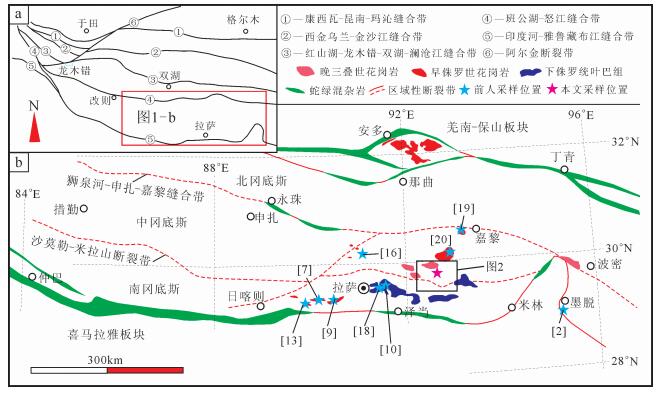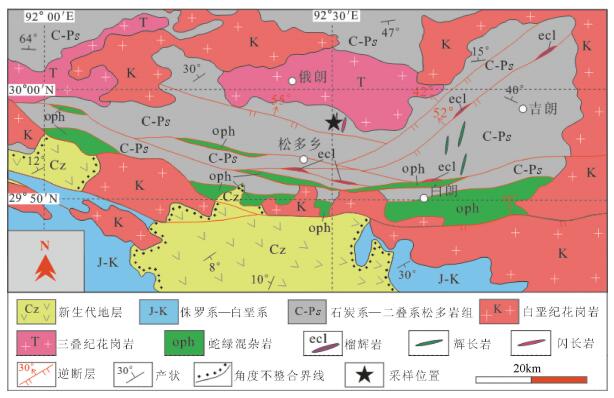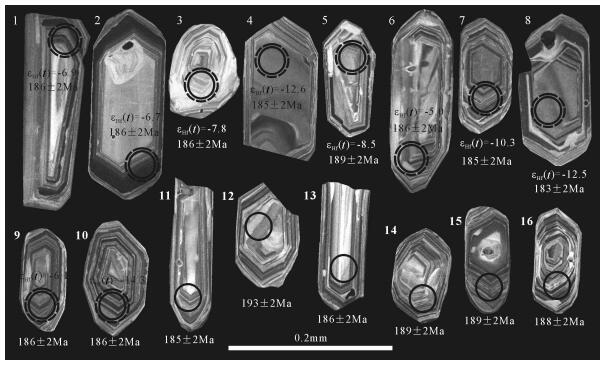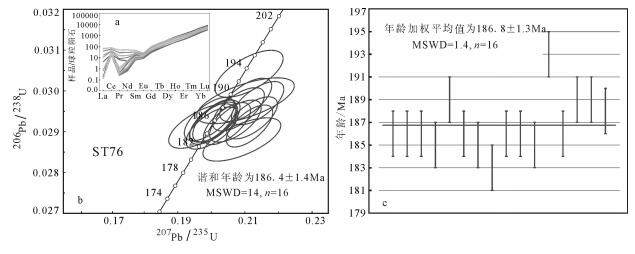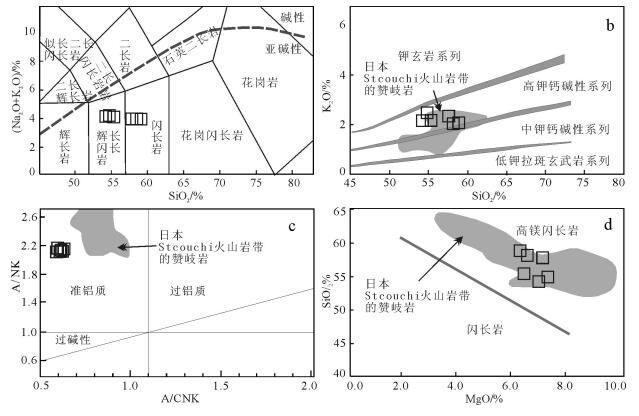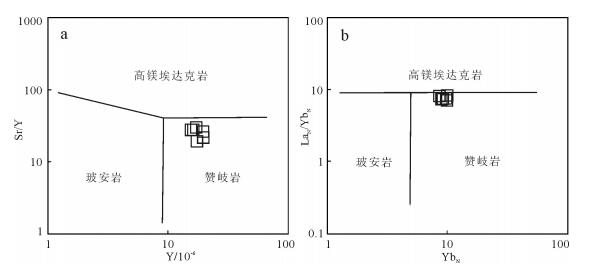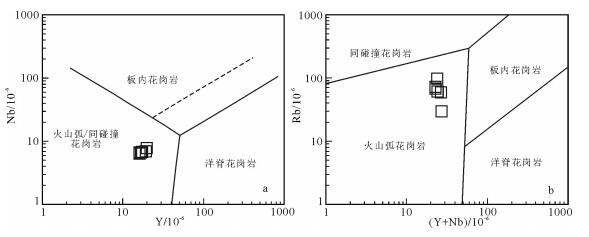The Early Jurassic subduction of Neo-Tethyan oceanic slab: Constraints from zircon U-Pb age and Hf isotopic compositions of Sumdo high-Mg diorite
-
摘要:
冈底斯岩浆岩带中东部松多地区新发现的高镁闪长岩对于探讨青藏高原新特提斯俯冲演化历史具有重要意义。通过松多高镁闪长岩的LA-ICP-MS锆石U-Pb年龄、锆石Hf同位素和全岩地球化学组成的研究,表明松多闪长岩的锆石U-Pb年龄加权平均值为186.8±1.3Ma。该类岩石具有高硅、高镁的特点,SiO2含量为54.17%~58.81%,MgO含量较高,介于6.26%~7.29%之间,Mg#值介于64~67之间,Cr和Ni含量高。该岩石富集轻稀土元素,具有平滑右倾的稀土元素配分曲线及弱负Eu异常。富集Rb、Ba、Pb、K等大离子亲石元素,亏损Nb、Ta、Ti等高场强元素。锆石负εHf(t)值(-5~-14.3)及远大于其侵入年龄的古老Hf模式年龄(1543~2129Ma),揭示松多早侏罗世闪长岩经历了古老地壳物质的部分熔融。Sr/Y-Y和(La/Yb)N-YbN判别图解显示,其形成可能与赞岐岩的岩浆作用过程相似,形成于消减带之上的地幔楔环境。综合研究表明,松多地区在早侏罗世处于雅鲁藏布新特提斯洋板片向欧亚大陆俯冲的活动陆缘构造背景。
-
关键词:
- 冈底斯 /
- 松多地区 /
- 早侏罗世 /
- LA-ICP-MS锆石U-Pb定年 /
- Hf同位素
Abstract:The high-Mg diorite newly discovered in Sumdo area in the eastern part of the Gangdise magmatic belt is of importance for investigating the evolution history of the subduction of Neo-Tethyan oceanic slab of Tibet. This paper reports LA-ICP-MS zircon U-Pb ages, zircon Hf isotopic and whole-rock major and trace element compositions of the high-Mg diorite. LA-ICP-MS zircon U-Pb isotopic dating indicates that the diorite was emplaced at 186.8±1.3Ma. It is characterized by high content of SiO2 (54.17%~58.81%), MgO (6.26%~7.29%), Mg# (64~67), Cr (294×10-6~373×10-6) and Ni (42×10-6~50×10-6). It is also characterized by smooth gently right-inclined REE patterns with slight enrichment of LREE and a little negative Eu anomaly. The large ion lithophile elements (LILEs) such as Rb, Ba, Pb, K are enriched, and the high field strength elements (HFSEs) such as Nb, Ta, Ti are depleted. LuHf isotopic study demonstrates that its εHf(t) values vary between -5 and -14.3, and the ancient zircon Hf crustal modal ages vary greatly from 1543Ma to 2129Ma, which indicates that the formation of Sumdo diorites resulted from partial melting of ancient crustal rocks. The discrimination diagrams of Sr/Y-Y and (La/Yb)N-YbN show that the high-Mg diorites were likely formed in a mantle wedge setting similar to the magmatic process of sanukitie. The comprehensive studies show that the Sumdo area was located in an active continental margin setting and affected by the subduction of the Yarlung Zangbo Neo-Tethyan oceanic slab towards Eurasia plate before Early Jurassic.
-
Keywords:
- Tibetan Plateau /
- Sumdo /
- Early Jurassic /
- LA-ICP-MS zircon U-Pb dating /
- Hf isotope
-
随着城市化进程的加快与人口数量迅速增多,生态环境变化对农业生产的影响已成为全球范围重点关注的问题之一[1]。据《全国生态环境十年变化(2000—2010年)调查评估报告》调查结果表明,全国生态安全形势极为严峻,生态保护与发展矛盾突出,主要表现在农业生产与开发导致的水土流失、土地沙化等问题加剧。中国作为以农业生产为国民经济基础的国家,农业生产的合理布局及可持续发展一直受到政府部门高度重视。在《中共中央、国务院关于建立国土空间规划体系并监督实施的若干意见》中指出“要在资源环境承载能力和国土空间开发适宜性评价的基础上,科学有序统筹布局生态、农业、城镇等功能空间”。
土地生产及农业适宜评估是农业区域开发与规划的重要步骤,这一领域国外研究多与GIS技术有机结合且多注重模型构建及单一作物的GIS应用[2-3]。Stork等[4]基于GIS方法在区域尺度上利用供水条件及土壤质量两大因素来评价薪柴生产潜力区域。Kumar等[5]采用频率比(FR)、层次分析法(AHP),结合遥感(RS)和地理信息系统(GIS)多重手段共同探索潜在的农业用地,对制定研究区可持续农业管理计划具有极好作用。Javad等[6]基于遥感(RS)和GIS技术,采用层次分析法和物质元素技术来评估和绘制大麦的种植布局,实验结果表明层次分析法和物质元素技术混合可使模型准确度更高。而国内研究偏重于应用,早期多以与农业生产相关的土壤、气候、地形等单一因素或单一植被展开研究。如土壤重金属元素的来源辨识、对生态环境污染风险的评价研究[7-9],或土壤养分含量动态变化跟踪及土培对策研究[10-12]。土地利用方式引起的土壤理化性质及生态效应变化等方面也有研究[13-15]。此外,在降水量变化特征及自然灾害对农业生产影响方面的研究也较为广泛[15-18]。现阶段随着国土空间规划相关政策提出,“资源环境承载能力与国土空间开发适宜性”(简称“双评价”)研究也逐渐开展[19-22]。总体看,已有研究大多具有较强的针对性和单一性,而关于不同时间尺度下的区域农业生产环境变化开展的农业适宜性评价鲜有报道。
本文运用ArcGIS的空间分析方法,采用南通市近年来气候条件变化、土壤肥力与土壤重金属污染情况等评价因子加权求和的方式,对南通市县市地区的农业生产适宜性进行分析,为1:50万精度及大比例尺图件关于农业生产要素的区域分析及动态变化影响分析提供参考方法,为推进南通市及更小尺度范围的地区了解区域农业生产环境变化并制定相应环境改善政策、开展农作物产业布局研究、识别农业生产合理区、国土空间规划方案制定提供依据支持。
1. 研究区概况
南通市地处江苏省东南部,处于沿海经济带与长江经济带T字形交汇中心,富集“黄金海岸”与“黄金水道”两大优越的空间地理位置资源,是长江流域重要的港口城市之一,也是中国沿海地区土地资源最丰富的地区之一。南通市凭借其独特的地理位置与丰富的自然资源已成为国内沿海地区农业优质发展的典型地区。南通市属长江三角洲冲积平原,全境地势平坦,多数地区海拔在2~6 m之间。全市现有耕地44.87×104 m2,以水田和旱地为主,当地农业产品以粮棉为主,盛产棉花和特种经济作物,耕地产出率高于全省平均水平[9]。南通市土壤多为水稻土、潮土及滨海盐土,整体土壤肥力较高,呈碱性土质[10]。
已有调查表明,当地年平均气温达到15~17℃,年平均日照时数在1700~2200 h之间,年平均降水量为1000~1100 mm,属于典型的气候温和、光照充足、雨水丰沛的农业适宜区,地处海陆过渡带(滨江临海),受季风影响明显,也是典型的自然灾害频发区。下辖海安县、如东县、如皋市、启东市、海门市,崇川区、港闸区、通州区,考虑到获取数据的重合性,本次研究将崇川区与港闸区合并为南通市辖区。
2. 数据来源与评价体系
2.1 数据来源
本次研究所用数据主要为空间数据和统计数据,其中,空间数据包含南通市行政区划图、南通市基础地理图;统计数据包括积温、年降水量、日照时数、土壤养分、土壤重金属元素含量。积温采用当地一年内日平均气温≥10℃的持续期间日平均气温的总和作为年积温数据;年降水量、日照时数来源于《南通市统计年鉴》(2013—2017);土壤肥力数据、土壤重金属数据来源于土壤肥力普查数据及巩万合等[8, 10]关于南通市土壤肥力及重金属的相关研究。具体如表 1所示。
表 1 数据来源Table 1. Data sources数据名称 数据来源 数据类型 积温 天气网历史天气数据的日平均温度 统计数据 年降水量 《南通市统计年鉴》(2013—2017) 统计数据 日照时数 《南通市统计年鉴》(2013—2017) 统计数据 土壤养分数据 全国第二次土壤普查数据 统计数据 土壤重金属数据 全国第二次土壤普查数据、巩万合等[8, 10]关于南通市土壤肥力及重金属 统计数据 南通市行政区划图 地理信息共享平台(https://www.tianditu.gov.cn) 空间数据 南通市基础地理图 地理信息共享平台(https://www.tianditu.gov.cn) 空间数据 2.2 评价体系构建
农业生产过程极易受多种因素影响,因此结合南通市生态环境特性与农业生产模式,选取积温、年降水量、日照时数、土壤养分(有机质、P、K)、土壤重金属(Cd、Cr、Hg、Pb、As)11个评价指标因子构建农业生产适应性评价体系,如表 2所示。这些评价因子对农业生产影响的范围及强度存在差异,结合南通市实际情况,采用德尔菲法[23-25]将所有指标对当地农业影响的重要程度逐一评分,最终确定各指标权重。在此基础上参考“双评价指南”,并与专家评定结合,共同划定同一因子的适宜程度等级。
表 2 农业生产适应性评价体系Table 2. Evaluation system of agricultural production adaptability评价指标 指标因子 权重 分值 分类 评价指标 指标因子 权重 分值 分类 气候 积温/℃ 0.15 1 < 5000 土壤 土壤磷含量/(mg·kg-1) 0.1 2 50~70 2 5000~5500 3 70~90 3 5500~5700 4 ≥90 4 ≥5700 Cd/(mg·kg-1) 0.05 1 ≥0.2 年降水量/mm 0.1 1 < 1000 2 0.1~0.2 2 1000~1500 3 < 0.1 3 ≥1500 Cr/(mg·kg-1) 0.05 1 ≥60 日照时数/h 0.1 1 1000~1400 2 50~60 2 1400~2200 3 < 50 3 2200~3000 Hg/(mg·kg-1) 0.05 1 ≥0.12 土壤 土壤有机质/% 0.1 1 < 0.6 2 0.1~0.12 2 0.6~1 3 < 0.1 3 1~2 Pb/(mg·kg-1) 0.05 1 ≥25 4 2~3 2 20~25 土壤钾含量/(mg·kg-1) 0.1 1 < 10 3 15~20 2 10~20 4 < 15 3 20~30 As/(mg·kg-1) 0.05 1 ≥8 4 ≥30 2 6~8 土壤钾含量/(mg·kg-1) 0.1 1 < 50 3 < 6 评价单元的综合得分是确定土地开发建设适宜性等级的基础,本次研究通过ArcGIS的空间统计方法,采用11个适宜性评价因子加权求和的数据模型来构建农业生产适宜性指数,计算公式如下所示:
Ti=n∑i=1Wi∗Ci (1) 式中:T代表南通市农业生产适宜性指数及综合得分,i=1,…,n代表第i个评价因子;W表示第i个评价因子的权重;C表示对应的评价因子等级评分。
基于ArcGIS软件平台,以南通市行政区划图为本底,所属县级区域为基本单位,对采集获取的各项数据进行空间叠加分析与属性空间化,构成多因子属性值的综合评价图,进而对南通市农业适宜性程度进行综合评价,划分为农业最适宜区、农业适宜区、农业较适宜区、农业一般适宜区[26-27]。
3. 评价过程与结果
3.1 气候变化
了解区域积温、降水演变规律、区域日照时数,可为农业环境条件筛选适宜种植的作物类型提供参考。
3.1.1 积温年际变化特征
分析积温年际变化有利于对该地区未来的农业生产气候条件做出合理预判。本研究对南通市近5年(2014—2018年)的积温年际变化进行统计,如图 1所示,近5年南通市不同区域积温主要分布在5358.5~5826.5℃之间,年际变化波动幅度较大,随年份递增积温整体呈波动上升趋势,这与王涛等[16]的研究结果一致。对比同一年份南通市各区域之间的积温变化,发现不同地区的积温变化特征基本随年份呈现统一变化规律。经统计,近5年南通市不同区域积温均高于5300℃,产生的热量满足了大部分农作物的需求,属于农业生产的适宜区域。
3.1.2 区域积温空间分布特征
区域积温图可通过直观展示积温具体情况来挖掘其空间分布特征。利用ArcGIS软件平台,以县级区域为单位叠加空间属性将南通市积温分布划分为4类积温区域(综合各地近5年平均积温)。如图 2所示,积温较高区域的温度集中在5563~5712℃之间,主要分布在南通市辖区、通州、海门、启东4个地区,占据了全市47.18%的面积,这部分地区纬度偏低、人口稠密、城市建设用地布局紧张、临江沿海工业聚集程度拥挤,长年处于南通市高积温区域。如东市、海安市区域积温在5494~5563℃之间,处于积温梯度中部,如皋地区积温低于5494℃,处于南通市低积温区域。
3.1.3 降水量与日照时数时间分布特征
图 3为南通市年均降水量与年日照时数的年际变化情况(2013—2017年),从图中历年降水数据可知,年降水量在2013—2016年基本呈逐年递增趋势,在2016年达到近年降水量最高值1921.4 mm,到2017年降水量陡减,同比上年减少了39.8%,表明南通市年降水量起伏波动变化大,极易受洪涝、干旱等气象灾害影响,因此应重点预测降水受灾风险区,提前做好防护措施,避免农业生产与城市基础设施遭受破坏。年日照时数的变化特征与年降水量完全相反,两者之间的变化规律呈负相关。
降水量与日照时数的月分布对农作物生长影响、农业环境变化、灾害风险预测提供分析依据。图 4为南通市降水量月分布情况(2013—2017年月平均数据),通过对降水量的分析,发现南通市全年降水大多集中于5~11月之间,占据年降水量的76.2%~86.3%,其中南通地区的降水峰值主要集中在6月中下旬至7月上中旬的梅雨期,因此应在梅雨期前夕做好重点防御工作。月日照时数按时间分布来看,6~7月的光照时数明显偏低,在光照强度与时间不足的条件下农作物难以进行有效的光合作用,进而导致农作物的减产与停产。此外,梅雨期降水集中,空气湿度与土壤湿度大,极易诱发病虫害[21]。
3.1.5 气候变化对南通市农业生产影响分析
农业对气候变化的反应敏感而脆弱,气候变化还会导致农作物生长过程发生改变[28]。南通市现代农业以小麦、大麦、稻谷等粮食作物与大豆、花生、油菜、棉花等经济作物作为主要农作物,农作物产业分布具备如下的地域特点,小麦、大麦、稻谷等粮食作物多分布在海安、如东、如皋等地区,花生、油菜、棉花等经济作物主要集中于启东、海门等沿海地区。南通市主要农作物的产业空间分布在一定程度上符合农作物对气候条件的要求。
根据南通市积温空间分布、降水量与日照特征对照分析,发现高积温气候适宜区域与经济作物分布区域高度重合,高积温区受沿海区位影响有降水量大、日照时数偏小等特点,可见对光热要求较高的油菜、棉花等作物极易受气候变化影响。对于处于粮食主产区、积温梯度中部的如东与海安来讲,气候变化特征与强度可能会对喜长日照的小麦产生影响,相对于喜高温、多湿、短日照的稻谷,气候变化对其影响较小。
总体看,气候变化对不同农作物的影响强度与范围差异性较大,且难以把控气候演变规律,因此可通过调整农田种植结构与农业布局模式、选育良种、加强气候灾害防控等措施来适应气候变化[29]。
3.2 土壤养分
3.2.1 土壤养分年际变化特征
图 5为南通市养分年际变化情况,随年份增加,全氮与有效磷呈递增趋势,土壤全氮含量浮动趋于稳定,至2012年达到12.5 mg/kg,增幅不足27%。有效磷的起伏变化较大,1982—2012年土壤有效磷增幅超过390%,至2012年含量达到20.6 mg/kg。土壤全氮与有效磷的逐年递增主要来自于有机肥的施用,与之相比,土壤速效钾的年际浮动极特殊,自1982—2012年经历了先减少后增加再减少的连续起伏过程。根据全国第二次土壤普查土壤养分分级标准,南通市土壤全氮与有效磷含量均满足土壤养分标准的二级要求,速效钾含量仅达到四级标准要求。
3.2.2 土壤养分评价
利用南通市各区域土壤养分空间分析,将土壤养分划为养分丰富、养分充足、养分较充足及养分基本充足4级(图 6)。海安、如东因土壤养分条件优越,列为土壤养分丰富区,通州、启东养分含量相对有所下滑,划为土壤养分充足地区,市辖区与海门市划为养分较充足区,与其他区域相比,如皋耕地面积相对偏少且土壤养分含量略有不足,可划分为养分基本充足地区。
从农业角度分析,海安与如东是养分丰富的粮食主产区,满足小麦、水稻等作物对土壤养分的需求,可进一步通过调整农业布局增加土壤养分丰富区域的利用率。通州、启东地区土壤养分充足,可达到油菜、蔬菜、棉花等经济作物的养分要求。
3.3 土壤重金属污染
3.3.1 土壤重金属污染统计分析
土壤重金属是评价耕地土壤环境质量的一项重要指标。表 3为南通市土壤重金属Hg、Pb、Cd、As和Cr的元素含量,根据已有研究发现[7-9],江苏省海岸带主要为碱性土壤,pH多集中在7.5~8.5之间,因此参考《土壤环境质量标准》(GB15618—1995)二级标准中土壤pH>7.5的标准值。
依据土壤环境质量标准,南通市土壤重金属含量均符合标准要求。通过对比,南通市各重金属平均含量与江苏省海岸带土壤重金属含量相似度较高,其中Cd元素含量均超过了江苏省土壤背景值,表明南通市及海岸带重金属污染来源可能相似,南通市是重要的粮食基地,有机肥、农药等大量施用增加了土壤养分,也造成了农用地土壤Cd等其他重金属富集。此外,南通市土壤中Hg元素的平均含量较高,这部分Hg的污染源主要来自工业三废与煤炭燃烧,土壤中的Hg元素富集会导致土壤肥力降低,妨碍农作物根系生长,通过食物链进入人体甚至危害人类健康。近年来,南通市第二产业发展迅速,已占据南通GDP比重的48.4%,可见工业发展对农业生产环境的影响极明显。其他重金属元素含量均低于江苏省土壤背景值。
3.3.2 土壤重金属污染评价
图 7为南通市各地区重金属含量,表 4为各地区综合污染指数,根据已有研究对土壤重金属的内梅罗指数进行计算与评价[7]。整体看,南通市各地区的综合污染指数均在0.26~0.4之间,污染程度处于安全阶段。从综合指数的分布看,重金属的分布也存在一定规律,启东的重金属含量最高,通州、海门、南通市辖区3个地区的指数相近,处于0.3~0.32之间,如皋、海安、如东的综合指数较低,可见重金属污染综合指数基本按照南东—北西方向由大到小呈阶梯状分布。沿海地带是工业发展、进出口集散地、人口密集的重要位置,因此由人类活动引发的重金属富集程度较内陆地区有所抬升。总体看,南通市各地区重金属污染对农业生产影响较小。
表 4 南通市各地区单因子指数与内梅罗综合污染指数Table 4. Index of single factor and comprehensive pollution index in different areas of Nantong区域 单因子指数 内梅罗综合指数 Cd Cr Pb As Hg 如皋 0.10 0.13 0.05 0.29 0.09 0.26 海安 0.11 0.13 0.04 0.28 0.09 0.26 启东 0.18 0.17 0.08 0.51 0.09 0.40 如东 0.18 0.15 0.05 0.30 0.09 0.27 通州 0.10 0.14 0.06 0.39 0.14 0.32 海门 0.17 0.16 0.05 0.34 0.10 0.30 南通 0.15 0.14 0.06 0.37 0.12 0.31 3.3.3 土壤重金属相关性分析
多种重金属元素之间的相关性分析基本反映了元素之间的关联情况,有助于辨识重金属污染来源[31]。表 5为土壤重金属之间的相关系数。Cd-Cr、Cr-As之间的Pearson相关性系数为0.792、0.758,p < 0.05,正相关呈显著,Pb-As之间的相关性系数为0.966,通过p < 0.01的检验,说明Pb与As之间的元素相关性很大,元素之间的同源性可能较高。其他元素之间的相关性略低。
表 5 土壤重金属之间的相关系数Table 5. Correlation coefficient among different heavy metals in soil项目 Cd Cr Pb As Hg Cd 1 Cr 0.792* 1 Pb 0.41 0.673 1 As 0.412 0.758* 0.966** 1 Hg -0.361 -0.163 0.214 0.143 1 注:*代表显著性相关(p < 0.05),**代表极显著相关(p < 0.01) 3.4 江苏海岸带滩涂资源与农业利用
土壤盐渍化是海岸带普遍存在的现象之一,海岸带大部分盐渍土主要集中在沿海滩涂,然而滩涂土壤的含盐量在空间分布上的不均与季节变化上的巨大差异导致盐分数据难以利用。海岸滩涂湿地实际是一种具有较强的气候调节、净化环境等功能的土地后备资源,随着土地资源的日渐紧张,大部分滩涂资源已被开发利用,且围垦后超过60%的土地作为耕地资源进行利用[32]。据了解,现今江苏省有超过2/3的海岸带处于淤长状态,每年新淤达到1333 km2[33]。虽然这些利用的滩涂存在含盐量过高的情况,然而随着新淤面积的不断增加,以及逐渐远离海岸与地表径流的冲洗,出露滩涂盐分随之下降。如东县作为南通市的滩涂大县,海平面以上滩涂面积达8×104 hm2,占南通市滩涂面积的50%,具备了持续生长的后备耕地资源[34]。目前改善土壤盐渍化的方法有很多,种植耐盐作物、水稻,添加土壤改良剂,进行秸秆覆盖、植被覆盖、调整耕作方式等人为措施均可达到降盐、控盐的作用[35],由此可见,如东县等沿海地区具有较强的农业发展潜力。
4. 适宜性区域分析
以农业生态环境为背景,按照南通市区域特点,参考相关行业标准依据专家经验评判确定指标权重及分级参数,建立以气候、土壤为主要指标的评价体系(详见2.2部分)。利用ArcGIS空间统计分析、叠加分析等技术为依托,通过对各指标综合分级空间计算统计(自然间断点分级法)与专家评定相结合的方式展开对南通市各县区农业生产适宜性综合性评价。由于南通市各区县气候条件相对适宜,土壤环境指标均在安全范围内,因此本研究讨论了各区县农业生产环境的相对适宜程度。启东的气候条件及土壤养分条件尚可,而土壤重金属单因子指数及内梅罗指数相对偏高且分值较低设置为一般适宜区域(四级适宜区),可种植如棉花这类重金属耐受性较好的经济作物,建立农产品加工生产基地,也可充分利用区位优势发展水产养殖业。如皋区位条件及连续性耕作,导致了该地气候及土壤养分等指标的综合分值偏低,也划分为一般适宜区范围,区内大多为砂壤土、中壤土等土质也可种植山药、马铃薯及四季蔬菜等。南通各县区中海安的综合分值最高,主要是土壤养分及土壤环境安全等指标级别较高所致,可适合大多数农作物种植。如东县与海安县情况类似,与南通市辖区划分为农业适宜生产区域也称为二级适宜区,可大规模种植四季蔬菜,因其低洼的地势条件及水源条件也发展水稻种植及水产养殖。而通州市、海门市各指标参数较为均匀,按综合分值划分为三级适宜区,因其优越的地理位置可作为上海市农产品供应基地开发,可大力发展形成蔬菜水果、水稻等需求农产品的种植基地及农业商品加工基地。
5. 结论
(1) 从气候的逐年变化情况看,南通市积温基本呈逐年递增趋势,高积温区多分布在纬度较低地区,如南通市辖区、通州、海门、启东,占据了全市面积的47.18%。降水量年际起伏波动较大,变化复杂,且多与年日照时数关系密切,其变化规律与日照时数呈负相关。
(2) 从土壤养分与质量的逐年变化看,土壤全氮与有效磷呈递增趋势,据全国第二次土壤普查土壤养分分级标准,南通市土壤全氮与有效磷处于土壤养分二级水平,速效钾含量偏低仅达到土壤养分四级要求。从养分富集程度的空间分布看,海安、如东为养分丰富区,通州、启东为养分充足地区,市辖区与海门市划为养分较充足区,如皋为养分基本充足区。
(3) 参照《土壤环境质量标准》,南通市土壤重金属含量均符合标准要求,全市综合污染指数在0.26~0.4之间,处于安全阶段。此外,相关性分析发现Pb与As之间相关性系数较高,元素同源性可能性较高。
(4) 根据农业生产适应性评价,将适宜区划分为4级,海安地区的农业生产环境达到最适宜程度(一级适宜区),南通市辖区与如东为二级农业生产适宜区,通州、海门划分为三级适宜区,启东、如皋为四级适宜区。
致谢: 锆石LA-ICP-MS原位微区U-Pb同位素测定得到中国地质大学(北京)苏犁教授的帮助,在此致以诚挚谢意。 -
图 1 冈底斯东段构造简图及其早侏罗世岩浆岩分布[3]
Figure 1. Sketch map of eastern Gangdise belt, showing the distribution of Early Jurassic magmatic rocks
图 9 松多闪长岩高镁安山岩分类图解[39]
Figure 9. The discrimination diagrams for HMA of Sumdo diorite
表 1 松多闪长岩(ST76)LA-ICP-MS锆石U-Th-Pb分析结果
Table 1 LA-ICP-MS U-Th-Pb analyses of zircons from the diorite (ST76) in Sumdo area
点号 含量/10-6 Th/U 207Pb/206Pb 207Pb/235U 206Pb/238U 207Pb/206Pb 207Pb/235U 206Pb/238U Th U 比值 1σ 比值 1σ 比值 1σ 年龄/Ma 1σ 年龄/Ma 1σ 年龄/Ma 1σ 1 206 580 0.36 0.0498 0.0012 0.2006 0.0048 0.0292 0.0003 186 34 186 4 186 2 2 349 930 0.38 0.0498 0.0011 0.2010 0.0043 0.0293 0.0003 185 29 186 4 186 2 3 238 650 0.37 0.0498 0.0012 0.2011 0.0049 0.0293 0.0003 187 36 186 4 186 2 4 193 303 0.64 0.0491 0.0017 0.1974 0.0067 0.0291 0.0004 154 56 183 6 185 2 5 220 495 0.44 0.0522 0.0013 0.2138 0.0051 0.0297 0.0004 294 34 197 4 189 2 6 303 776 0.39 0.0508 0.0012 0.2047 0.0046 0.0292 0.0003 233 31 189 4 186 2 7 216 580 0.37 0.0499 0.0013 0.2002 0.0051 0.0291 0.0003 191 38 185 4 185 2 8 320 657 0.49 0.0526 0.0020 0.2091 0.0077 0.0288 0.0004 313 90 193 6 183 2 9 218 547 0.40 0.0493 0.0012 0.1994 0.0049 0.0293 0.0004 163 35 185 4 186 2 10 352 700 0.50 0.0524 0.0012 0.2121 0.0050 0.0293 0.0003 304 33 195 4 186 2 11 619 916 0.68 0.0526 0.0011 0.2114 0.0046 0.0291 0.0003 312 28 195 4 185 2 12 192 339 0.57 0.0504 0.0016 0.2112 0.0067 0.0304 0.0004 212 50 195 6 193 2 13 285 659 0.43 0.0514 0.0013 0.2072 0.0051 0.0293 0.0003 257 35 191 4 186 2 14 558 722 0.77 0.0512 0.0024 0.2102 0.0096 0.0298 0.0004 251 111 194 8 189 2 15 542 777 0.70 0.0512 0.0013 0.2102 0.0051 0.0298 0.0004 249 34 194 4 189 2 16 498 830 0.60 0.0511 0.0013 0.2081 0.0051 0.0296 0.0004 244 35 192 4 188 2 表 2 松多闪长岩(ST76)锆石LA-ICP-MS原位稀土元素分析结果
Table 2 The trace element compositions of the zircons in the diorite (ST76) in Sumdo area by LA-ICP-MS
10-6 点号 La Ce Pr Nd Sm Eu Gd Tb Dy Ho Er Tm Yb Lu ∑REE 01 1.06 13.52 0.65 2.43 2.93 0.82 14.58 5.99 84.12 35.28 176.75 50.02 653.12 173.49 1215 02 0.04 19.89 0.03 0.69 2.60 1.12 16.78 7.60 106.02 46.08 228.32 63.78 826.25 216.30 1215 03 0.03 15.42 0.03 0.49 1.58 0.86 10.71 4.76 68.08 31.25 162.83 47.74 640.72 181.13 1169 04 0.03 11.07 0.03 0.67 1.36 0.68 7.30 2.67 35.69 14.80 73.49 21.68 299.68 86.18 559 05 0.03 12.04 0.02 0.29 0.98 0.51 6.28 2.42 34.33 15.12 77.90 23.49 325.66 93.27 597 06 9.93 37.44 2.87 14.47 5.09 1.32 17.55 7.02 95.91 40.46 202.72 56.38 731.30 195.07 1424 07 0.05 13.19 0.03 0.39 1.45 0.71 8.26 3.58 50.99 22.82 121.19 36.10 502.57 145.96 914 08 0.04 19.79 0.05 0.69 2.05 1.10 12.39 5.08 71.78 31.91 167.15 50.52 675.85 188.40 1235 09 0.04 15.96 0.03 0.54 1.42 0.79 9.14 3.76 54.75 24.74 130.63 38.96 543.96 162.47 996 10 0.05 18.40 0.04 1.41 3.51 1.23 19.64 7.75 104.23 42.02 203.29 55.23 692.35 178.56 1338 11 2.73 25.86 0.81 4.94 3.28 1.19 14.93 5.51 73.71 29.84 146.62 40.51 524.2 140.75 1026 12 0.16 9.13 0.08 1.81 4.33 1.22 20.39 7.44 91.56 34.18 156.2 40.25 478.05 120.97 978 13 16.65 50.20 4.87 25.11 7.22 1.59 16.45 5.73 75.11 30.49 150.33 42.01 550.88 145.16 1135 14 0.20 21.11 0.12 2.40 4.81 1.57 22.51 8.24 104.69 41.36 196.11 52.39 661.73 163.38 1295 15 0.03 14.71 0.04 0.73 2.18 0.89 12.93 4.98 66.21 26.29 122.53 32.55 413.27 106.38 819 16 4.21 27.21 1.47 7.51 3.62 1.03 10.93 3.97 50.45 21.12 108.11 30.39 402.18 115.79 804 表 3 松多闪长岩(ST76)LA-ICP-MS锆石Lu-Hf同位素组成
Table 3 The Lu-Hf isotope compositions of the zircons in the diorite (ST76) in Sumdo area as measured by LA-ICP-MS
点号 年龄/Ma 176Yb/177Hf 2σ 176Lu/177Hf 2σ 176Hf/177Hf 2σ εHf(0) εHf(t) TDM1 TDM2 fLu/Hf 01 186 0.034757 0.000514 0.001385 0.000030 0.282468 0.000028 -10.8 -6.9 1121 1662 -0.96 02 186 0.020124 0.000198 0.000731 0.000008 0.282470 0.000018 -10.7 -6.7 1099 1652 -0.98 03 186 0.069570 0.000895 0.002615 0.000053 0.282446 0.000026 -11.5 -7.8 1191 1719 -0.92 04 185 0.039694 0.000791 0.001311 0.000024 0.282307 0.000021 -16.5 -12.6 1347 2021 -0.96 05 189 0.040310 0.000422 0.001442 0.000009 0.282420 0.000021 -12.5 -8.5 1191 1768 -0.96 06 186 0.021209 0.000292 0.000783 0.000011 0.282519 0.000018 -9.0 -5.0 1032 1543 -0.98 07 185 0.042573 0.001080 0.001651 0.000054 0.282373 0.000023 -14.1 -10.3 1265 1877 -0.95 08 183 0.026939 0.000259 0.000966 0.000007 0.282308 0.000018 -16.4 -12.5 1333 2018 -0.97 09 186 0.025039 0.000459 0.000925 0.000016 0.282489 0.000020 -10.0 -6.1 1078 1611 -0.97 10 186 0.026789 0.000106 0.000917 0.000007 0.282257 0.000019 -18.2 -14.3 1402 2129 -0.97 表 4 松多闪长岩全岩主量、微量和稀土元素测定结果
Table 4 Major, trace element and REE compositions of the diorite in Sumdo area
样号 ST76-1 ST76-2 ST76-3 ST76-4 ST76-5 ST76-6 样号 ST76-1 ST76-2 ST76-3 ST76-4 ST76-5 ST76-6 SiO2 58.81 58.10 57.71 54.85 54.17 55.32 Li 87.20 72.26 60.30 31.12 31.46 24.72 TiO2 0.62 0.65 0.69 0.71 0.67 0.65 P 870.4 794.6 799.4 626.55 565.80 635.40 Al2O3 11.20 11.05 11.26 11.90 12.09 11.72 K 29360 24620 28740 16187 15728 17942 TFe2O3 7.48 7.82 8.18 8.70 8.58 8.41 Sc 51.98 47.56 51.84 36.98 37.56 39.84 MnO 0.12 0.13 0.13 0.14 0.14 0.13 Ti 5220 4766 5140 4038 4090 4286 MgO 6.26 6.54 7.10 7.29 6.97 6.41 V 275.8 249.2 272.6 238.7 244.1 254.0 CaO 6.98 7.36 6.93 7.45 8.04 7.43 Cr 326.8 294.2 339.8 318.8 329.0 373.4 Na2O 1.84 1.84 1.62 1.71 1.97 1.91 Mn 1060.8 981.4 1036.8 1157.4 1185.0 1214.0 K2O 2.06 2.05 2.34 2.49 2.18 2.19 Co 37.80 36.44 39.76 37.60 38.66 42.26 P2O5 0.13 0.13 0.13 0.12 0.11 0.12 Ni 43.78 42.66 45.82 42.74 43.60 51.32 烧失量 4.07 3.91 3.48 4.02 4.46 5.10 Cu 62.48 46.38 34.44 56.76 45.56 34.78 总量 99.57 99.58 99.57 99.38 99.38 99.39 Zn 57.86 59.12 54.62 66.37 70.42 61.22 Na2O+K2 3.90 3.89 3.96 4.20 4.14 4.10 Ga 17.38 15.47 15.53 14.07 14.00 13.83 A/CNK 0.62 0.59 0.63 0.63 0.60 0.62 Rb 29.74 63.58 59.12 76.92 74.72 97.10 A/NK 2.13 2.11 2.16 2.16 2.16 2.13 Sr 441.6 510.0 510.8 440.0 440.0 338.4 La 19.91 17.09 17.85 17.47 16.92 16.85 Y 19.86 17.26 19.53 16.20 15.96 17.54 Ce 43.14 37.72 39.32 37.78 36.74 36.96 Zr 121.46 108.64 107.82 103.66 103.88 99.44 Pr 5.17 4.52 4.77 4.62 4.47 4.62 Nb 7.49 6.73 6.82 6.47 6.39 6.33 Nd 19.94 17.40 18.88 17.28 16.71 17.64 Cs 2.94 2.41 3.29 2.52 2.33 3.06 Sm 4.20 3.67 4.05 3.62 3.49 3.76 Ba 448.0 435.8 374.6 425.2 454.8 383.4 Eu 1.06 0.93 0.99 0.92 0.90 0.95 Hf 2.86 2.61 2.64 2.62 2.60 2.34 Gd 3.73 3.28 3.64 3.40 3.33 3.63 Ta 0.45 0.41 0.42 0.43 0.42 0.41 Tb 0.54 0.48 0.54 0.49 0.48 0.52 Pb 7.79 8.56 7.12 9.07 10.71 8.80 Dy 3.24 2.86 3.21 3.01 2.96 3.22 Th 6.85 6.32 5.79 7.41 7.56 6.80 Ho 0.63 0.57 0.63 0.62 0.61 0.65 U 1.27 1.17 1.12 1.58 1.59 1.50 Er 1.83 1.63 1.83 1.73 1.70 1.84 Ta/Yb 0.27 0.28 0.26 0.27 0.27 0.24 Tm 0.26 0.23 0.25 0.26 0.25 0.27 Th/Yb 4.07 4.24 3.57 4.59 4.74 4.02 Yb 1.68 1.49 1.62 1.62 1.60 1.69 Nb+Y 27.35 23.99 26.35 22.66 22.35 23.87 Lu 0.24 0.21 0.24 0.25 0.25 0.26 注:主量元素含量单位为%,微量和稀土元素为10-6 表 5 冈底斯南缘早侏罗世岩浆岩年龄信息统计
Table 5 Age information of Early Jurassic magmatic rocks in southern margin of Gangdese
序号 样品编号 样品岩性 测试方法 年龄结果 采样位置 数据来源 1 S16T76 闪长岩 LA-ICP-MS锆石U-Pb 186.4±1.3Ma 松多乡北 本文 2 X-20 辉长岩 LA-ICP-MS锆石U-Pb 185.9±0.3Ma 墨脱南背崩 [2] 3 TB-1-6 英云闪长岩 LA-ICP-MS锆石U-Pb 179.7±1.7Ma 东嘎乡 [13] 4 TB-1-4 闪长岩(包体) LA-ICP-MS锆石U-Pb 177.4±1.7Ma 东嘎乡 [13] 5 13GB-10 安山岩 LA-ICP-MS锆石U-Pb 188.8±1.8Ma 得明顶 [50] 6 X03 流纹岩 LA-ICP-MS锆石U-Pb 174.4±1.7Ma 甲马沟叶巴组 [18] 7 Dy1425-2 黑云二长花岗岩 锆石U-Pb 187±10Ma 嘉黎县布久岩体 [19] 8 B553-1 花岗闪长岩 40Ar/30Ar 198.2±0.3Ma 金达地区 [20] 9 DZ05-1 英安岩 SHRIMP锆石U-Pb 174.2±3.6Ma 达孜 [10] 10 T384 变形花岗岩 LA-ICP-MS锆石U-Pb 178±1Ma 尼木大桥 [9] 11 b9041 白云母二长花岗岩 SHRIMP锆石U-Pb 190±8Ma 宁中 [16] 12 b7 白云母二长花岗岩 SHRIMP锆石U-Pb 193±7Ma 宁中 [16] 13 b50-2 白云母二长花岗岩 SHRIMP锆石U-Pb 191±10Ma 宁中 [16] 14 ST134A 花岗岩 SHRIMP锆石U-Pb 188.1±1.4Ma 南木林东 [7] 15 DZ-7 英安岩 锆石U-Pb 181±5Ma 达孜 [46] -
潘桂棠, 莫宣学, 侯增谦, 等.冈底斯造山带的时空结构及演化[J].岩石学报, 2006, 22(3):521-533. http://d.old.wanfangdata.com.cn/Periodical/ysxb98200603001 董汉文, 许志琴, 李源, 等.冈底斯东段墨脱地区早侏罗世辉长岩的成因及其构造意义[J].岩石学报, 2016, 33(12):3624-3634. http://www.wanfangdata.com.cn/details/detail.do?_type=perio&id=QKC20162017042100246217 朱弟成, 潘桂棠, 王立全, 等.西藏冈底斯侏罗纪岩浆作用的时空分布及构造环境[J].地质通报, 2008, 27(4):458-468. doi: 10.3969/j.issn.1671-2552.2008.04.003 朱弟成, 赵志丹, 牛耀龄, 等.拉萨地体的起源和古生代构造演化[J].高校地质学报, 2012, 18(1):1-15. doi: 10.3969/j.issn.1006-7493.2012.01.001 纪伟强, 吴福元, 锺孙霖, 等.西藏南部冈底斯岩基花岗岩时代与岩石成因[J].中国科学(D辑), 2009, 39(7):849-871. http://www.cnki.com.cn/Article/CJFDTOTAL-JDXK200907002.htm Ji W Q, Wu F Y, Chung S L, et al.Zircon U-Pb geochronology and Hf isotopic constraints on petrogenesis of the Gangdese batholith, southern Tibet[J].Chemical Geology, 2009, 262(3/4):229-245. doi: 10.1016-j.chemgeo.2009.01.020/
Chu M F, Chung S L, Song B, et al.Zircon U-Pb and Hf isotope constraints on the Mesozoic tectonics and crustal evolution of southern Tibet[J].Geology, 2006, 34(9):745-748. doi: 10.1130/G22725.1
和钟铧, 杨德明, 郑常青, 等.冈底斯带门巴花岗岩同位素测年及其对新特提斯洋俯冲时代的约束[J].地质论评, 2006, 52(1):100-106. doi: 10.3321/j.issn:0371-5736.2006.01.013 张宏飞, 徐旺春, 郭建秋, 等.冈底斯南缘变形花岗岩锆石U-Pb年龄和Hf同位素组成:新特提斯洋早侏罗世俯冲作用的证据[J].岩石学报, 2007, 23(6):1347-1353. doi: 10.3969/j.issn.1000-0569.2007.06.011 Zhu D C, Pan G T, Chung S L, et al.SHRIMP Zircon Age and Geochemical Constraints on the Origin of Lower Jurassic Volcanic Rocks from the Yeba Formation, Southern Gangdese, South Tibet[J]. International Geology Review, 2008, 50(5):442-471. doi: 10.2747/0020-6814.50.5.442
Guo L S, Liu Y L, Liu S W, et al.Petrogenesis of Early to Middle Jurassic granitoid rocks from the Gangdese belt, southern Tibet:Implications for early history of the Neo-Tethys[J]. Lithos, 2013, 179:320-333. doi: 10.1016/j.lithos.2013.06.011
Kang Z Q, Xu J F, Wilde S A, et al. Geochronology and geochemistry of the Sangri Group volcanic rocks, southern Lhasa terrane:Implications for the early subduction history of the Neo-Tethys and Gangdese magmatic arc[J].Lithos, 2014, 200/201:157-168. doi: 10.1016/j.lithos.2014.04.019
邱检生, 王睿强, 赵姣龙, 等.冈底斯中段早侏罗世辉长岩-花岗岩杂岩体成因及其对新特提斯构造演化的启示:以日喀则东嘎岩体为例[J].岩石学报, 2015, 31(12):3569-3580. http://d.old.wanfangdata.com.cn/Periodical/ysxb98201512005 黄丰, 许继峰, 陈建林, 等.早侏罗世叶巴组与桑日群火山岩:特提斯洋俯冲过程中的陆缘弧与洋内弧[J].岩石学报, 2015, 31(7):2089-2100. http://d.old.wanfangdata.com.cn/Periodical/ysxb98201507022 Dong H W, Xu Z Q, Li Y, et al.The Mesozoic metamorphicmagmatic events in the Medog area, the Eastern Himalayan Syntaxis:Constraints from zircon U-Pb geochronology, trace elements and Hf isotope compositions in granitoids[J].International Journal of Earth Sciences, 2015, 104(1):61-74. doi: 10.1007/s00531-014-1057-y
刘琦胜, 江万, 简平, 等.宁中白云母二长花岗岩SHRIMP锆石U-Pb年龄及岩石地球化学特征[J].岩石学报, 2006, 22(3):643-652. http://d.old.wanfangdata.com.cn/Periodical/ysxb98200603013 Geng Q R, Pan G T, Zheng L L, et al. The eastern Himalayan syntaxis:Major tectonic domains, ophiolitic mélanges and geologic evolution[J]. Journal of Asian Earth Sciences, 2006, 27(3):265-285. doi: 10.1016/j.jseaes.2005.03.009
董彦辉, 许继峰, 曾庆高, 等.存在比桑日群弧火山岩更早的新特提斯洋俯冲记录么?[J].岩石学报, 2006, 22(3):661-668. http://d.old.wanfangdata.com.cn/Periodical/ysxb98200603015 向树元, 泽仁扎西, 田立富, 等.中华人民共和国1:25万区域地质调查报告嘉黎县幅[M].北京:地质出版社, 2010. 杨德明, 和钟铧, 王天武, 等.中华人民共和国1:25万区域地质调查报告门巴区幅[M].北京:地质出版社, 2005. 杨经绥, 许志琴, 耿全如, 等.中国境内可能存在一条新的高压/超高压(?)变质带-青藏高原拉萨地体中发现榴辉岩带[J].地质学报, 2006, 80(12):1787-1792. doi: 10.3321/j.issn:0001-5717.2006.12.001 王斌, 解超明, 李才, 等.青藏高原松多地区温木朗蛇绿岩的发现及其地质意义[J].地质通报, 2017, 36(11):2076-2081. doi: 10.3969/j.issn.1671-2552.2017.11.017 陈松永, 杨经绥, 罗立强, 等.西藏拉萨地块MORB型榴辉岩的岩石地球化学特征[J].地质通报, 2007, 26(10):1327-1339. doi: 10.3969/j.issn.1671-2552.2007.10.011 徐向珍, 杨经绥, 李天福, 等.青藏高原拉萨地块松多榴辉岩的锆石SHRIMP U-Pb年龄及锆石中的包裹体[J].地质通报, 2007, 26(10):1340-1355. doi: 10.3969/j.issn.1671-2552.2007.10.012 Cheng H, Zhang C, Jeffrey D, et al. Zircon U-Pb and garnet Lu-Hf geochronology of eclogites from the Lhasa Block, Tibet[J]. Lithos, 2012, 155:341-359. doi: 10.1016/j.lithos.2012.09.011
Cheng H, Liu Y M, Jeffrey D, et al.Combined U-Pb, Lu-Hf, Sm-Nd and Ar-Ar multichronometric dating on the Bailang eclogite constrains the closure timing of the Paleo-Tethys Ocean in the Lhasa terrane, Tibet[J]. Gondwana Research, 2015, 28:1482-1499. doi: 10.1016/j.gr.2014.09.017
Yuan H L, Gao S, Liu X M, et al.Accurate U-Pb age and trace elment deteminations of zircon by laser ablation-inductively coupled plasma-mass spectrometry[J].Geostandards and Geoanlytical Research, 2004, 11:357-370. http://cn.bing.com/academic/profile?id=4a8e7a7fca3d10ce694c49bdb9efd4b5&encoded=0&v=paper_preview&mkt=zh-cn
Hu Z C, Liu Y S, Gao S, et al.Improved in situ Hf isotope ratio analysis of zircon using newly designed X skimmer cone and Jet sample cone in combination with the addition of nitrogen by laser ablation multiple collector ICP-MS[J]. Journal of Analytical Atomic Spectrometry, 2012, 27:1391-1399. doi: 10.1039/c2ja30078h
Liu Y S, Gao S, Hu Z C, et al.Continental and oceanic crust recycling-induced melt-peridotite interactions in the Trans-North China Orogen:U-Pb dating, Hf isotopes and trace elements in zircons of mantle xenoliths[J].Journal of Petrology, 2010, 51:537-571. doi: 10.1093/petrology/egp082
Hoskin P W O, Black L P.Metamorphic zircon formation by solid-state recrystallization of protolith igneous zircon[J].Journal of Metamorphic Geology, 2000, 18:423-439. http://www.wanfangdata.com.cn/details/detail.do?_type=perio&id=JJ026563309
吴福元, 李献华, 郑永飞, 等.Lu-Hf同位素体系及其岩石学应用[J].岩石学报, 2007, 23(2):185-220. http://d.old.wanfangdata.com.cn/Periodical/ysxb98200702001 Amelin Y, Lee D C, Halliday A N, et al. Nature of the Earth's earliest crust from hafnium isotopes in single detrital zircons[J].Nature, 1999, 399:252-255. doi: 10.1038/20426
Rickwood P C.Boundary lines within petrologic diagrams which use oxides of major and elements[J].Lithos, 1989, 22:247-263. doi: 10.1016/0024-4937(89)90028-5
Middlemost E A K.Iron oxidation ratios, norms and the classification of volcanic rocks[J].Chemical Geology, 1989, 77:19-26. doi: 10.1016/0009-2541(89)90011-9
Maniar P D, Piccoli P M.Tectonic discrimination of granitoids[J]. Geological Society of America Bulletin, 1989, 101(5):635-643. doi: 10.1130/0016-7606(1989)101<0635:TDOG>2.3.CO;2
Boynton W V.Cosmochemistry of the rare earth elements:Meteorites studies[J].Development in Geochemistry, 1984:63-114. http://cn.bing.com/academic/profile?id=a86bc72c95d06bcdf62c0e1eb55bf851&encoded=0&v=paper_preview&mkt=zh-cn
Sun S S, McDonough W F.Chemical and isotopic systematics of oceanic basalt:implications for mantle composition and processes[J].Geological Society, London, Specical Publications, 1989, 42:313-345. doi: 10.1144/GSL.SP.1989.042.01.19
付长亮, 孙德有, 张兴洲, 等.吉林珲春三叠纪高镁闪长岩的发现及地质意义[J].岩石学报, 2010, 26(4):1089-1102. http://d.old.wanfangdata.com.cn/Periodical/ysxb98201004007 Kamei A, Owada M, Nagao T, et al. High-Mg diorites derived from sanukitic HMA magmas, Kyushu Island, southwest Japan arc:Evidence from clinopyroxene and whole rock compositions[J]. Lithos, 2004, 75:359-371. doi: 10.1016/j.lithos.2004.03.006
Kelemen P B, Hanghoj K, Greene A R, et al. One View of the Geochemistry of Subduction-Related Magmatic Arcs, with an Emphasis on Primitive Andesite and Lower Crust[J].Treatise on Geochemistry, 2003, 3:593-659. https://www.researchgate.net/publication/234393905_One_View_of_the_Geochemistry_of_Subduction-Related_Magmatic_Arcs_with_an_Emphasis_on_Primitive_Andesite_and_Lower_Crust
张旗, 王焰, 钱青, 等.晚太古代Sanukite (赞岐岩)与地球早期演化[J].岩石学报, 2004, 20(6):1355-1362. http://d.old.wanfangdata.com.cn/Periodical/ysxb98200406005 张旗, 钱青, 翟明国, 等.Sanukite(赞岐岩)的地球化学特征、成因及其地球动力学意义[J].岩石矿物学杂志, 2005, 24(2):117-125. doi: 10.3969/j.issn.1000-6524.2005.02.005 李化启, 蔡智慧, 陈松永, 等.拉萨地体中的印支期造山事件及年代学证据[J].岩石学报, 2008, 24(7):1595-1604. http://www.wanfangdata.com.cn/details/detail.do?_type=perio&id=ysxb98200807015 李化启, 许志琴, 杨经绥, 等.拉萨地体内松多榴辉岩的同碰撞折返:来自构造变形和40Ar/39Ar年代学的证据[J].地学前缘, 2011, 18(3):66-78. http://d.old.wanfangdata.com.cn/Periodical/dxqy201103008 Zedde D, Wortel M. Shallow slab detachment as a transient source of heat at midlithospheric depths[J]. Tectonics, 2001, 20(6):868-882. doi: 10.1029/2001TC900018
更全如, 潘桂棠, 王立全, 等.西藏冈底斯带叶巴组火山岩同位素地质年代[J].沉积与特提斯地质, 2006, 26(1):1-7. doi: 10.3969/j.issn.1009-3850.2006.01.001 Zhu D C, Zhao Z D, Niu Y L, et al.The Lhasa Terrane:Record of a microcontinent and its histories of drift and growth[J].Earth and Planetary Science Letters, 2011, 301(1/2):241-255. doi: 10.1016-j.epsl.2010.11.005/
England P, Houseman G. Finite strain calculations of continental deformation 2. Comparison with the India-Asia collision zone[J]. Journal of Geophysical Research, 1986, 91(3):3664-3676. doi: 10.1029-JB091iB03p03664/
Murphy M A, Yin A, Harrison T M, et al. Did the Indo-Asian collision alone create the Tibetan Plateau?[J]. Geology, 1997, 25(8):719-722. doi: 10.1130/0091-7613(1997)025<0719:DTIACA>2.3.CO;2
熊秋伟, 陈建林, 许继峰, 等.拉萨地块南部得明顶地区叶巴组火山岩LA-ICP-MS锆石U-Pb年龄、地球化学特征及其成因[J].地质通报, 2015, 34(9):1645-1655. doi: 10.3969/j.issn.1671-2552.2015.09.006 王玉净, 松冈笃.藏南泽当雅鲁藏布缝合带中的三叠纪放射虫[J].微体古生物学报, 2002, 19(3):215-227. doi: 10.3969/j.issn.1000-0674.2002.03.001



 下载:
下载:








